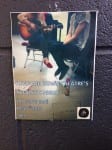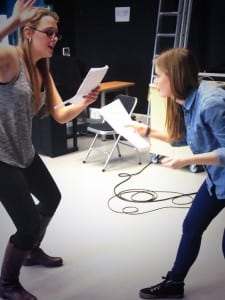After having a small work in progress showing with some other students , many questions arose about the structure of our performance and whether or not we would be able to restructure and mash up some of our scenes. There was no question that the scenes were not good just that some didn’t flow as well into others.
Many of our scenes have an over arching theme which either makes the audience laugh or think about what they have just seen. Its like a steady roller coaster into dark and light places through through the use of different texts. We didn’t want the audience to have to over-think to much so a restructure was on the cards, we wrote each of our scenes and transitions on a piece of paper and laid them on the floor. As a group we were able to discuss and develop a new structure which would enable the audience those moments of relief after one of our darker scenes. We also didn’t want to cram in all of the high energy scenes into one half of the show because then the pace and rhythm would drag .
By working together we found the moments that were lower than others and moved and changed things round. This was a good process to have gone through as it showed us everything we had altogether but also showed that we could work as a team .
Category Archives: Archive
Sparking Interest With Music
Marketing and advertising our companies show has been a enjoyable but yet challenging time. With all the theatre performances that are already happening in the Lincoln Performing Arts Center (LPAC) we have to showcase something which is going to spark interest and attention to our potential audience members.
Thus being why we as a company decided to hold an Acoustic Night which was held on 1st of May at the Lpac. This idea to hold an Acoustic Night arose from what our company was about , we take pieces of text, lyrics and speeches and change and deliver them in different ways taking them out of their original context. This linking to the acoustic night because our performers were taking songs and doing covers of them in their own unique way. For example Toxic by Brittany Spears was sung in a slow and soft way which completely contrasted the songs original performance.
To gain interest in our acoustic night we created posters and advertised on social media such as creating an event on facebook and tweeting about it on twitter. We also thought it would be nice if our audience members could take away a small souvenir which would help spread the word of our company but also be a nice way of them remembering us .”you may think its a waste of time to plan much of anything on a few dollars and cents, but if you follow some simple rules you’ll be suprised how much of a splash you can make on a tiny budget.” (Wallis, 2005,p84) However little money we had we wanted to make an impact on our audience so we decided to get some stickers printed. This was a relatively cheap marketing tool which we could stick on anything from people to posters. And our audience at the acoustic night loved them, they all thought that they were a nice touch to a chilled evening of music.
The actual evening went really well we had an audience of around 30-40 and everybody had a great time . Donations to our theatre company were made from audience members and we raised some money which would go back into the costs of our performance which we couldn’t be more delighted with. This night enabled to also promote our show ‘Take Me By The Tongue’ May 29th and people were able to buy their tickets at the Acoustic Night which also really boosted our sales .
Wallis, L. (2005) In Good Company. Currency Press: Australia. P.84
Shake the Week
Following on from using individually constructed Shakespearean ‘dialogues’ as transitional scenes, we were at the point of devising the final scene, the creme de la creme. It only seemed plausible that after using male monologues already, that the women’s voice of Shakespeare should be voiced, after all the interesting heroine characters of Shakespeare are either portrayed as the crazy or the virginal submissive. Therefore the characters such as Lady MacBeth, Juliet and Viola deserved to be re-interpreted and thus delivered in a comedic style. Sounds obscene, unrealistic?
Yet it is studying these notorious monologues hardly and uncovering the underscoring themes that helped to focus from another angle and therefore really bring the humour to light. For example, Juliet’s monologue that talks of her husband of three hours, Romeo, being banished for Tybalt’s death we understand as her weeping for Romeo, her recent husband, given the context of the whole play. Yet taking this monologue completely out of the context of Romeo and Juliet and focusing on the main aspect of the monologue; that Romeo has gone, enables the hilarity of the situation to ensue if we remember that she is a ‘Newlywed’.
And so finding comedic links between all of these female monologues created the perfect set up for a ‘Stand Up’ style outset for the final scene. Thus with certain aspects of these monologues being comedic through their themes, it is the themes that evoked the style of ‘Mock the Week’, and is what the scene is loosely based on. With each of the 6 performers adapting elements of a stand up comedian’s repertoire and channelling some of their comic timing in their deliverance of the monologues, these texts will hopefully achieve the transitions from monologues to ‘gags’. Therefore channelling the comedienne Sarah Millican whilst delivering Juliet’s monologue “Shall I speak ill of him that is my husband?..” helped Jess Jarvis’ characterisation of developing comic timing as well as the new perception of this ‘Geordie Newlywed’…
How now, what news?
One of the reasons Shakespeare’s plays have remained so popular for so long is their ability to be adapted to the context of the time. While the text and the story lines remain the same, in many instances over the twentieth and twenty first century the Shakespearean performances that have and are being produced bare very little resemblance to one another, and yet neither presentation of each play can be said to be “wrong”. It is stated that Shakespeare was ‘a man before his time’, and that by simply moving his characters into our century we can see his predictions of the future from when he was alive. Whether or not one agree’s with this statement it is clear that Shakespeare has been done and redone over the ages. So is it a challenge for us to recontextualise Shakespeare’s texts, or are we conforming to the norm of the time?
I would suggest that while we are indeed following in the footsteps of many directors and producers, we may find this task more challenging than our predecessors. This is not only because reinterpreting words that are no longer part of our day to day language can be a challenge for the mind, but is also partly because a plethora of “reinterpretations” have already been produced and presented, thus potentially limiting our claim to originality. Well, challenge accepted.
Having collected a number of texts which we believed could be altered or reinterpreted we shared and discussed our ideas before handing the baton over to our director. Having taken on board our (the performers) creative ideas she refined the texts and combined them with her own creative vision for our Shakespeare scenes. Yes! There are more than one! Without indulging too much detail, so as not to ruin the surprise, I can tell you that we have dialogues made out of monologues, monologues made out of sonnets and soliloquy presented in a way that we at least have never experienced before.
“If it were done when tis done, then ’twere well it were done quickly” (Shakespeare, Act 1, Scene 7 Line )
Picture by Kirsty Jakins, 2014
Dialogue as opposed to Monologue
Concluding the decision of using themes of Power, Fame, Beauty and Feminism throughout the performance, it was the general consensus amongst the cast that using Shakespeare within our piece was a fundamental aspect due to the challenge of re-interpreting Shakespeare being a challenge we openly accepted. Thus looking at the male monologues in particular from various plays such as Hamlet, MacBeth and King Lear links were found between certain characters. For instance subtle links were found between Hamlet and Titus Andronicus’ monologues in their theme of contemplation, or rather I interpreted them thus. Therefore by editing both of these to create a dialogue between both characters, this was taking them completely out of the context of the play as their deliverance would be comedic, as opposed to them originally being a part of a tragic play.
Subtle links were found between King Lear and Titus also in terms of their maddening tone, with MacBeth and the character of Caliban it seemed that their similiar plan of plotting murder evoked comedic tones and so coupling these seemed appropriate. As well as pairing King Lear’s famous “O reason not the need…” monologue with Hamlet’s monologue, they both comparatively sound alike a teenage tantrum once read as such. And so these 4 individual pairings seemed to each produce themes of Contemplation, Madness, Murder and Indulgence, and due to each of their ‘dialogues’ lasting roughly 2 minutes it seemed that they would work well as transitional scenes, acting as sub-themes, between the main themes consisting of Pop Culture, Power, Fame, Beauty, Feminism and Comedy.





